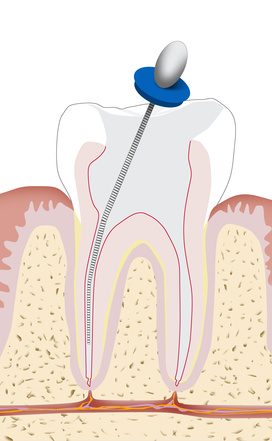Root Canal Treatment explained
Why would I need root canal?
 Inside the middle of every tooth is pulp tissue, euphemistically called ‘the nerve”. The pulp is a remnant of the tooth’s original formation. Once the pulp’s job is done and the tooth is fully formed and erupted into the mouth as a fully functioning tooth, the blood supply to the pulp is greatly reduced and it functions at a much lower level. The pulp lays down new tooth tooth structure on the inside of the tooth, called secondary dentine AND the pulp contains nerve fibres that sends signals to the brain when the tooth is challenged by, for example, tooth decay, a fracture or root sensitivity…leading to inflammation and PAIN (pulpitis).
Inside the middle of every tooth is pulp tissue, euphemistically called ‘the nerve”. The pulp is a remnant of the tooth’s original formation. Once the pulp’s job is done and the tooth is fully formed and erupted into the mouth as a fully functioning tooth, the blood supply to the pulp is greatly reduced and it functions at a much lower level. The pulp lays down new tooth tooth structure on the inside of the tooth, called secondary dentine AND the pulp contains nerve fibres that sends signals to the brain when the tooth is challenged by, for example, tooth decay, a fracture or root sensitivity…leading to inflammation and PAIN (pulpitis).
If the pulpitis is reversible and the cause can be removed, the pulp tissue may recover. This generally takes many months, long after the cause has been removed and the pain and other symptoms have subsided. It is common that if a patient comes under greater stress and starts to grind their teeth (bruxism) it will be the tooth that had a pulpitis in the preceding 9 months that will cause pain first. Once again, removal of the new cause may alleviate the symptoms.
If the pulpitis is irreversible, it is said to be chronic and pulp death is inevitable at some time in the future…days, weeks, months or years. The pulp tissue has now lost sufficient blood supply to be able to heal itself. As the pulp tissue dies, dead tissue affects adjecent living tissue inside the tooth, until finally all the pulp tissue dies inside the tooth. There is a now a space inside the tooth with dead tissue or no (liquified) tissue.
- If the pulp dies as a result of a sudded blow to the tooth, the dead tissue may remain sterile for many decades and cause no pain or other symptoms.
- If the pulp dies as a result of a deep cavity, bacteria from the mouth will invade the inside of the tooth and gain entry to the pulp chamber/canal. There is no blood supply inside the tooth to fight the bacterial invasion/infection, so the bacteria fester away until they spread out into the surrounding jaw where the body can fight back. But the body cannot totally eliminate the infection because the source remains hidden in the root canal.
To treat an infection in the jaw resulting from a dead and infected dental pulp, the dead and infected material must be removed. There are two options:
- removal of the tooth, including the dead/infected pulp.
- Root canal treatment to removed the dead/infected pulp, while keeping the rest of the tooth.
All dentists are trained to carry out endodontic treatment. On some occasions complicated and emergency cases are referred to an Endodontist, dentists who specialise in root canal treatment. Most teeth can be treated. Occasionally, a tooth can’t be saved because the root canals are not accessible, the root is severely fractured, the tooth doesn’t have adequate bone support, or the tooth cannot be restored,
If specialist care is needed your dentist will discuss this with you. If you would like a second opinion, ask your dentist for a referral to an Endodontist.
How long does it take?
Modern endodontic root canal cleaning systems have dramatically shortened the time in which a root canal can be cleaned and shaped, ready for filling. However, speed is not necessarily an advantage. Cleaning agents are used as an essential part of cleaning infected canals. These agents require time to effectively permeate through the tooth structure to reach hidden nooks and grannies and fuly disinfect the inside of the tooth.
- where the pulp tissue is sterile and there is no infection, root canal treatment can be completed in one visit,
- Where the pulp tissue and is infected and spreading into the jaw and canal is uncomplicated, root canal treatment can be completed in two visits.
- Where the infection is larger and the root canal system more complicated treatment may take longer.
For more information there are excellent reference sites on the internet such as the Victorian Government health information site:
and another resource of the American Association of Endodontists:
- MALCOLM J. GRENNESS,
B.D.Sc., L.D.S., M.Med.Sc., PhD, F.R.A.C.D.S
DENTAL SURGEON
Call: (03) 6224 3575
158 Collins Street, Hobart
Office Hours
Monday – Friday 8.45am-5.15pm
Send an Email
collinsdentalcentre@gmail.com
